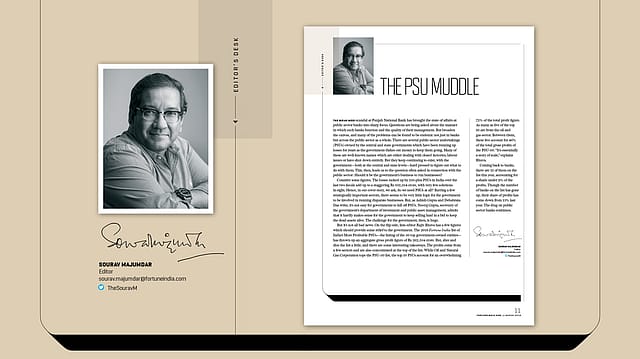
The Nirav Modi scandal at Punjab National Bank has brought the state of affairs at public sector banks into sharp focus. Questions are being asked about the manner in which such banks function and the quality of their management. But broaden the canvas, and many of the problems can be found to be endemic not just in banks but across the public sector as a whole. There are several public sector undertakings (PSUs) owned by the central and state governments which have been running up losses for years as the government dishes out money to keep them going. Many of these are well-known names which are either dealing with closed factories, labour issues or have shut down entirely. But they keep continuing to exist, with the government—both at the central and state levels—hard pressed to figure out what to do with them. This, then, leads us to the question often asked in connection with the public sector: Should it be the government’s business to run businesses?
Consider some figures. The losses racked up by 150-plus PSUs in India over the last two fiscals add up to a staggering Rs 102,354 crore, with very few solutions in sight. Hence, in our cover story, we ask, do we need PSUs at all? Barring a few strategically important sectors, there seems to be very little logic for the government to be involved in running disparate businesses. But, as Ashish Gupta and Debabrata Das write, it’s not easy for governments to kill off PSUs. Neeraj Gupta, secretary of the government’s department of investment and public asset management, admits that it hardly makes sense for the government to keep selling land in a bid to keep the dead assets alive. The challenge for the government, then, is huge.
But it’s not all bad news. On the flip side, lists editor Rajiv Bhuva has a few figures which should provide some relief to the government. The 2018 Fortune India list of India’s Most Profitable PSUs—the listing of the 50 top government-owned entities— has thrown up an aggregate gross profit figure of Rs 262,354 crore. But, slice and dice the list a little, and there are some interesting takeaways. The profits come from a few sectors and are also concentrated at the top of the list. While Oil and Natural Gas Corporation tops the PSU-50 list, the top 10 PSUs account for an overwhelming 72% of the total profit figure.
December 2025
The annual Fortune 500 India list, the definitive compendium of corporate performance, is out. This year, the cumulative revenue of the Fortune 500 India companies has breached $2 trillion for the first time. Plus, find out which are the Best B-schools in India.
As many as five of the top 10 are from the oil and gas sector. Between them, these five account for 46% of the total gross profits of the PSU-50. “It’s essentially a story of scale,” explains Bhuva.
Coming back to banks, there are 12 of them on the list this year, accounting for a shade under 9% of the profits. Though the number of banks on the list has gone up, their share of profits has come down from 13% last year. The drag on public sector banks continues.
(The Fortune India March 2018 issue is on stands. Subscribe here)
